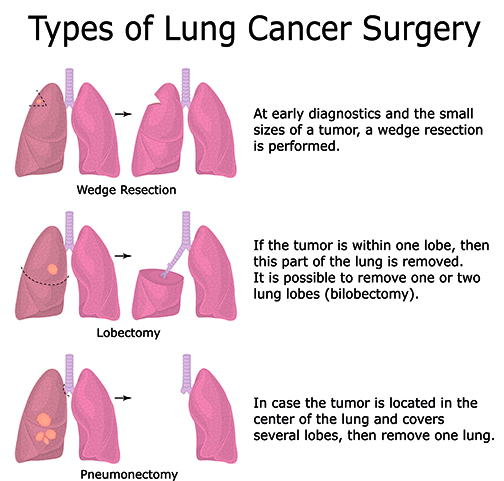We treat each patient individually, taking into consideration the patient’s age and overall health as well as the type, size, location and stage of the cancer. All of these factors help us choose the appropriate plan of care for each patient.
Before surgery, the surgeon evaluates how well a patient's lungs are functioning. This information tells the surgeon how much lung tissue can be removed and how well the patient can expect to function after surgery.
The goal of lung cancer surgery is the removal of the part of the lung that has the cancer, as well as the surrounding lymph nodes. Lymph nodes are removed and examined to see if the cancer has spread.
HOW SURGERY IS PERFORMED
• Robotic-assisted surgery A minimally invasive procedure that highly trained surgeons perform with the da Vinci® Xi™ robotic system for a lobectomy. The surgeon docks the robotic console right next to the patient and uses this tool as an extension of their hands and magnification of their vision. Read More: Ask the Experts
• Thoracoscopy or VATS (video-assisted thoracic surgery). Removal of the tumor and surrounding lymph nodes by a minimally invasive thoracic surgery in which a tiny camera (thoracoscope) and surgical instruments are inserted into the patient’s chest through one or more of the small incisions in the chest wall.
TYPES OF SURGERY
The most common types of surgery for lung cancer:

- Wedge resection-removal. Removal of the tumor and the part of the surrounding lung in the shape of a piece of pie (wedge). This procedure is performed to obtain a biopsy.
The tissue can be sent to the pathologist for examination while the patient is still in surgery. If the pathologist determines that it contains cancer, the surgeon then performs a lobectomy. A surgeon may recommend this procedure for a patient who cannot tolerate a lobectomy. - Segmentectomy or segmental resection. Removal of part of the lobe where the cancer is located. The segmentectomy is typically performed on patients who have limited lung capacity and can’t tolerate the removal of a larger section of the lung. This is also a good option for patients with small early-stage tumors (measuring less than two centimeters).
- Lobectomy. Removal of the lung lobe, which contains the cancer with the goal to cure lung cancer. The lobectomy is considered the gold standard for lung cancer treatment.
- Pneumonectomy. Removal of the entire lung, usually because the tumor is centrally located.
More Information About Surgery
The surgeon explains and discusses any complications that may occur during or after surgery. These can include infection, bleeding, and shortness of breath. Usually there is a fair amount of pain after the procedure, but the appropriate medications are provided to help control it.
Very often, a catheter (thin tube) is inserted in the patient’s back just prior to the surgery and is used as a way to give medication to control the pain during the hospital stay. This method of pain management is commonly called an epidural.
To learn more:
• Our lung cancer team
• Patient education for surgery
• Patient forms for surgery

